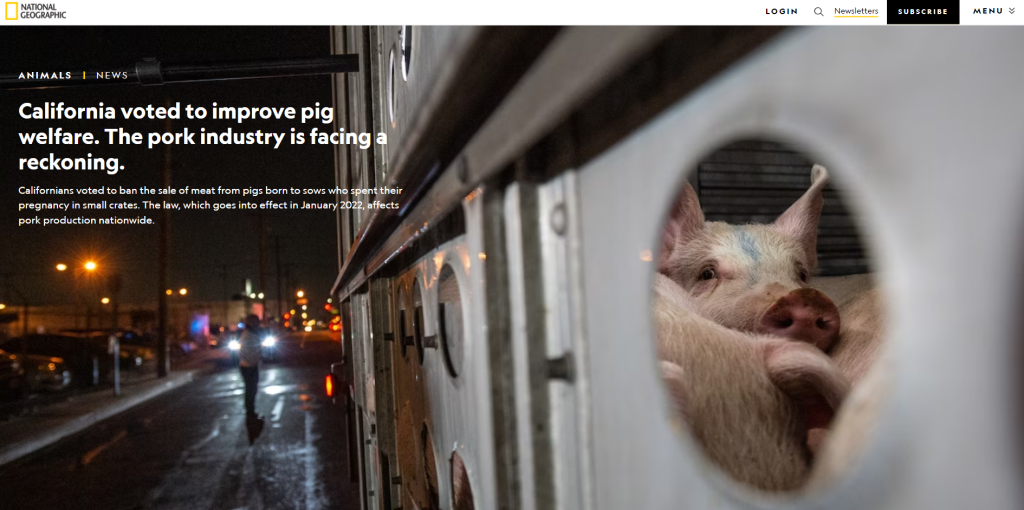Liberals Pursue Pig Welfare

BYNATASHA DALY
PUBLISHED AUGUST 13, 2021
• 11 MIN READ
Stand up, lie down, turn around, and stretch their legs. Pregnant pigs should live in large enough spaces to do those things, Californians have declared.
So have the people of Massachusetts. Whole Foods concurs, as do McDonald’s, Walmart, and more than 50 other companies that sell pork.
But the majority of the country’s six million breeding sows spend a significant portion of their four-month pregnancies—if not all—in gestation crates: seven-by-two-foot metal cages they can’t turn or stretch in. By keeping pigs isolated in small spaces, pork producers can keep more pigs in a single building and prevent sows from potentially injuring each other, they say.
Nine states have banned the use of gestation crates. In 2018, California voters passed a ballot initiative that took it a step further. As of January 2022, California prohibits the sale of meat produced anywhere in the U.S. from pigs whose mothers were kept in gestation crates and from calves who have been confined in veal crates. The initiative—nearly identical to one Massachusetts passed in 2016—also bans the sale of eggs laid by caged hens.
Veal and egg producers are on track to comply, the AP reports, but most pork producers are not. Only 4 percent of the country’s 66,000 pork producers currently meet the new laws’ minimum space requirements of 24 square feet.
Though the law was passed at the state level, it’s having national consequences. It’s been hailed by animal welfare advocates as a groundbreaking improvement—and it’s been attacked by much of the meat industry as an overreach that’ll make meat more expensive for everyone. For example: An Iowa pig farm would have to overhaul its pig housing if it wants to sell pork in California, even if some of the pigs it raises still end up in other states.
Pork is a $23 billion industry in the United States. Trade groups have challenged the law in federal court, but so far, the courts have sided with California voters. With less than five months before the law goes into effect, opponents are running out of options.

PHOTOGRAPH BY STEPHEN BAY, ALAMY
Maximized for efficiency
Most pigs in the U.S. live in “concentrated animal feeding operations” (CAFOs). Often referred to as “factory farms,” these large-scale industrial facilities are designed to maximize production at minimal cost.
Gestation crates and farrowing crates—for newborn piglets, who are kept separated from the mother, suckling through slats—are standard. After three weeks, piglets are removed and sows are impregnated again. Sows can produce up to three litters per year, according to the American Meat Science Association. The process is typically repeated until a sow is three or four years old, and then she is slaughtered for meat.
Jim Monroe, spokesperson for the National Pork Producers Council (NPPC), a trade group that opposes California’s law, says the conventional hog farming setup is “informed by veterinarians based on animal behavior and what’s needed to protect pigs and keep food safe.” Monroe contends that “no one is more committed to excellent animal care than American hog farmers.”
Josh Balk, vice president of farmed animal welfare at the Humane Society of the United States—which drafted Proposition 12—says crates cause physical and psychological distress. It’s “absolute common sense that an animal should be able to turn around,” Balk says, citing studies that have shown that crated sows can suffer from weakened bones, overgrown hooves, urinary tract infections, and repeated bar biting—behavior often indicating psychological distress.
While the federal Animal Welfare Act regulates the treatment of animals used in research and for exhibition at places like zoos, there are no federal laws that regulate treatment of animals farmed for food, says Delcianna Winders, director of Vermont Law School’s Animal Law Program. Where regulations do exist, they’ve been imposed at the state level, often following public outrage, such as bans on caging egg-laying hens, currently in place in nine states.
California’s and Massachusetts’ laws will be the strictest in the country. “It’s really telling about how woefully inadequate our legal protections are,” Winders says. “Something that gives [pregnant pigs and calves] enough space to turn around is the most celebrated protection for these animals.”
Galina Hale, a professor of economics at the University of California, Santa Cruz, and expert at sustainability nonprofit Food System Innovations, says the lack of federal regulations is “a form of a subsidy to factory farming. They are allowed to do whatever they want to increase production per dollar of investment.” The lack of regulations applies to all farms but, she argues, but it especially rewards large-scale farms that densely pack their facilities with pigs, putting smaller farms that give their pigs more space at an economic disadvantage.

PHOTOGRAPH BY JO-ANNE MCARTHUR, WE ANIMALS MEDIA
The controversy
The NPPC and other meat industry trade groups have argued in court that California’s law violates the U.S. Constitution’s Commerce Clause by allowing one state to regulate businesses outside its borders.
“California, which doesn’t have any significant commercial hog production, is seeking to regulate how farmers across the country operate, imposing onerous regulations, inspection and permitting requirements, and highly prescriptive measures on livestock farmers,” the NPPC says on its website.
But so far, three federal courts have disagreed with that argument, ruling that Californians have the constitutional right to regulate products sold in their state. The Supreme Court declined to hear the case in June 2021.
The NPCC’s Monroe argues that overhauling the industry to cater to specific states is unsustainable. “How does our national pork production system respond when another state decides to establish different pork production standards?” he says.
Not all pork producers are pushing back. Hormel, a top pork producer, has said that it will fully comply with the law. Perdue has come out in favor of it. Its pork divisions, Niman Ranch and Coleman Farms, make up less than one percent of the national pork industry, but none of their farms, which own 32,800 sows, use crates.
“There’s nothing humane about keeping a sow in a seven-foot-by-two-foot crate for the four-month gestation period,” says Chris Oliviero, general manager at Niman Ranch, which comprises 740 family farms in Iowa. “There’s a high cost to cheap food that we don’t talk about very much, and Prop. 12 is one step in the right direction—it’s better for animals, farmers, and communities.”
On the other hand, higher welfare standards translate to higher production costs, and higher costs for supermarket shoppers. Niman Ranch pork costs more on the shelf, but the tradeoff is that its farmers go beyond the requirements set by California’s Proposition 12, Oliviero says.
Sows live either outside on pasture or in groups in barns, with the freedom to move around. Niman farmers don’t cut off pigs’ tails (an industry-standard practice, typically done without painkillers, to prevent pigs from biting each others’ tails). Niman also provides pigs with hay bedding (as opposed to industry-standard concrete or slatted floors), allowing them to engage in natural behaviors like digging and nesting.
Opponents, including the NPPC, argue the regulations will decrease productivity and harm small farmers.
Austin Frerick, deputy director and agriculture specialist at the Thurman Arnold Project, a competition policy research group at Yale University, expects the opposite will be true. “The ones complaining are the industrial operations that pack hogs into metal sheds that never see the light of day or even a blade of grass,” he says. “That’s why I see this legislation as extremely pro-farmer, as it will enhance the market position of traditional hog farmers over corporate operations.” (Since 1992 in Iowa, for example, the number of farms has decreased by 80 percent, but the number of pigs has risen, as small farms have been replaced by industrial-scale CAFOs.)
Will bacon disappear?
Despite recent headlines proclaiming otherwise, bacon will not disappear from California in 2021. But it may get more expensive.
It’ll cost “billions of dollars” for U.S. hog farms to renovate their facilities, the NPPC’s Monroe says.
“The cost of production has to go up,” Hale says. “That’s obvious.”
But Californians knew price increases were a possibility when they voted to pass this bill—the opposition made that a central part of their argument against passage of the law in 2018.
Just how much pork prices may increase is still unclear, and it will depend in part on how many farms move to comply with the regulations. If many choose not to, California’s pork supply may drop and prices could rise more significantly. One study, by a consulting group hired by opponents, estimates that if California’s pork supply decreases by half, prices for pork may rise by 60 percent, for instance. But the California Department of Food and Agriculture estimates that the price for pork and veal per Californian will go up by only $10 per year.
One thing that’s certain: Most pork suppliers won’t have upgraded their facilities for pregnant hogs by January 2022, when the law goes into effect. “If there is not an extension on the timeline and/or other changes, I currently expect notable reductions in the volume of some pork items available in [California] come January 2022,” says Glynn Tonsor, an agricultural economist at Kansas State University.
Producers that choose to comply likely would renovate only a portion of their facilities and make sure that meat from that section of the farm is allocated to California markets, Tonsor and Hale say.
The industry has long talked about phasing out gestation crates, but it has delayed repeatedly, says Winders, from Vermont Law School. California’s law may be the push that’s needed, she says, “but I have to underscore that it’s such a baby step.”
Nonetheless, it’s a step in the right direction, Oliviero says. “Most change starts small and builds momentum over time.”
